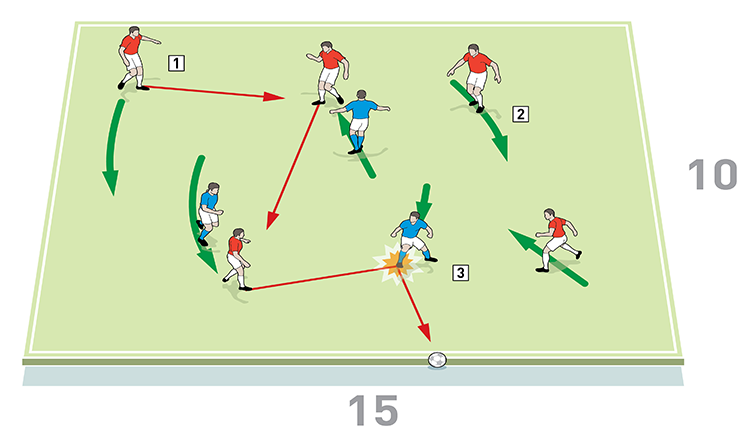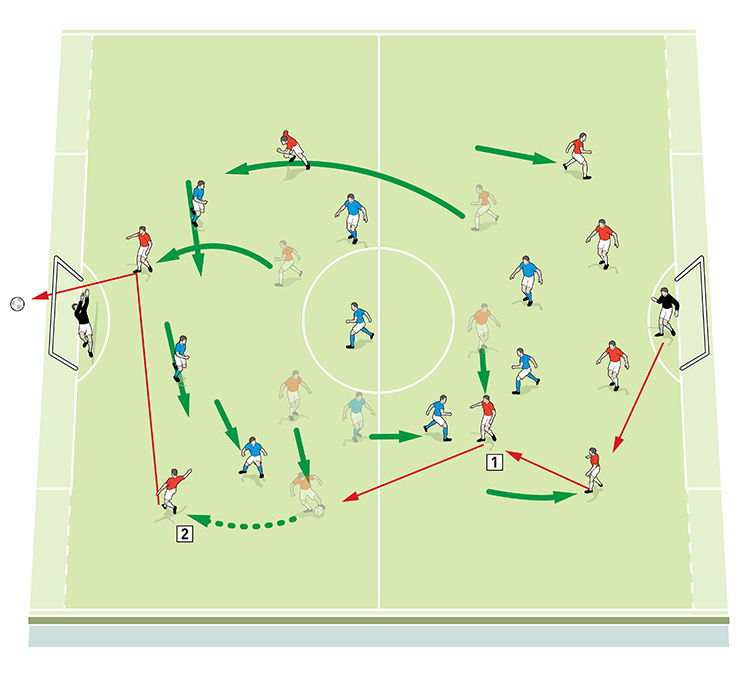Improve possession to penetrate
Through a series of activities, this session stresses the importance of combination play, both in the central midfield and out on the wings, and it encourages players to change the point of attack with clever switches of play.

| Area | Up to two thirds of pitch |
| Equipment | Balls, bibs, cones, 2 mini goals, 2 full size goals |
| No. of Players | Up to 16 players + 2 goalkeepers |
| Session Time | Total: 60mins, Warm-up: 10mins, Restricted space: 15mins, One goal with counter: 15mins, 9v9 game: 20mins |
This session is all about improving a team’s possession in order to penetrate more effectively and it is very match realistic in its approach. Through a series of activities, it stresses the importance of combination play, both in the central midfield and out on the wings, and it encourages players to change the point of attack with clever switches of play.
It creates numerous situations where maintaining possession is of vital importance, with players encouraged to keep hold of the ball until the opportunity to make a penetrating pass presents itself. Further more, it tests decision-making and awareness because players need to recognise when – and when not – to play that final penetrating pass.
Our sessions are always possession based, but focusing on different aspects of the game. We would look to run this session, or similar, every few weeks.
What do I get the players to do?
Warm-up
We set up an area of 15x10 yards for the warm-up. We’re using eight players, split into five possession players and three defenders. We play a 5v3 possession game and the team of five must try to keep the ball away from the defenders by finding as much space as possible to receive and pass, as shown [1]. The defenders press and try to block or intercept the ball. If they gain possession, they must clear it out of the area.
Shape is important and the possession team should look to use the full width and depth of the area and keep changing the point of attack. We want to see good combination play and quick ball movement from the passing players in order to keep it away from the defenders.
We would run this with two teams of eight taking turns.
1

2. The possession players must make good use of space and find positions to receive and pass
3. Defenders try to block or intercept the ball. Here they intercept and clear the ball out of the area
What do I get the players to do next?
Restricted space
We set up an area of 30x20 yards with a 10-yard end zone in front of an unguarded goal. This is a 6v4 game using 10 players split into an attacking team of six and a defending team of four. Two of the attackers and one defender are positioned in the end zone.
The coach starts by passing a ball to the attacking players, who must pass and keep possession in the midfield zone, as shown [2]. When they have achieved a set number of passes, they are free to look for an opening to play the ball down the pitch to their two strikers in the end zone.
Once the ball is played into the end zone, one of the attackers and any of the defenders from the midfield zone can follow it into the end zone. The attackers must try to score.
We want to see players making the correct decisions about when to keep possession and when to play the ball forward. We also want to see the strikers continually making runs, checking to receive a pass and spinning out if they don’t get the ball.
2

2. The attackers pass the ball until they spot an opening to play it forward to a team mate in the end zone
3. Once the ball is played into the end zone, an attacker can follow to support the attack
4. Any of the defenders can follow the ball into the end zone to help stop the attackers scoring
One goal with counter
Setting up in the same 30x20-yard area, this activity is the same as the previous practice, but we now add two target goals at the end opposite the main goal. This gives the defenders an opportunity to counter-attack if they win the ball, as shown [3].
3

2. This time the defender wins the ball and passes back to his team mate in the end zone
3. The defending team launch a quick counter-attack and score in one of the target goals
To progress this game, we could add more defenders. We could also remove the the end zone restrictions and make it free play.
How would you put this into a game situation?
9v9 game
We set up for this game between the 18-yard lines using the full width of the pitch, with a goal at either end, as shown [4]. It’s a 9v9 game including goalkeepers and we play with normal rules, with one team set up in a 2-4-2 formation and the other in a 3-3-2. We focus on coaching the team playing 2-4-2. This formation operates with more width and would stretch the 3-3-2 team, creating more space to keep possession.
4

2. A clever dribble from the forward puts him in a position to switch the point of attack with a well-timed cross
What are the key things to look out for?
Effective combination play is important to all of the activities in this training session, particularly quick passes through the central areas and those using combinations with players out on the flanks.
We also want to see players looking to change the point of attack, switching play to exploit space in less congested parts of the playing area.
Team shape is important to all the activities and we want to see that players are prepared to use the full depth and width of the playing area.
Players should also be able to show us they can improvise with their dribbling and that they can finish clinically.
Editor's Picks
Attacking transitions
Deep runs in the final third
Using the goalkeeper in build-up play
Intensive boxes drill with goals
Penetrating the final third
Creating and finishing
My philosophy
Pressing initiation
Compact team movement
Coaches' Testimonials

Alan Pardew

Arsène Wenger

Brendan Rodgers

Carlos Carvalhal

José Mourinho

Jürgen Klopp

Pep Guardiola

Roy Hodgson

Sir Alex Ferguson

Steven Gerrard
Coaches' Testimonials

Gerald Kearney, Downtown Las Vegas Soccer Club

Paul Butler, Florida, USA

Rick Shields, Springboro, USA

Tony Green, Pierrefonds Titans, Quebec, Canada
Join the world's leading coaches and managers and discover for yourself one of the best kept secrets in coaching. No other training tool on the planet is written or read by the calibre of names you’ll find in Elite Soccer.
In a recent survey 92% of subscribers said Elite Soccer makes them more confident, 89% said it makes them a more effective coach and 91% said it makes them more inspired.
Get Monthly Inspiration
All the latest techniques and approaches
Since 2010 Elite Soccer has given subscribers exclusive insight into the training ground practices of the world’s best coaches. Published in partnership with the League Managers Association we have unparalleled access to the leading lights in the English leagues, as well as a host of international managers.
Elite Soccer exclusively features sessions written by the coaches themselves. There are no observed sessions and no sessions “in the style of”, just first-hand advice delivered direct to you from the coach.









